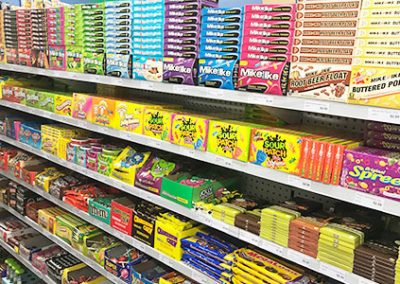I Luv Candi Fundamentals Explained
I Luv Candi Fundamentals Explained
Blog Article
Fascination About I Luv Candi
Table of ContentsThe 45-Second Trick For I Luv CandiI Luv Candi - The FactsOur I Luv Candi PDFsSee This Report on I Luv CandiEverything about I Luv Candi
You can also approximate your own earnings by using various assumptions with our financial plan for a sweet store. Typical month-to-month profits: $2,000 This sort of sweet shop is usually a little, family-run company, possibly understood to citizens yet not drawing in multitudes of vacationers or passersby. The store may offer a selection of common candies and a couple of homemade treats.
The store does not usually bring uncommon or pricey things, concentrating instead on budget-friendly deals with in order to keep regular sales. Assuming an average costs of $5 per customer and around 400 customers each month, the month-to-month revenue for this sweet-shop would certainly be about. Average regular monthly revenue: $20,000 This candy store advantages from its strategic area in a busy urban location, bring in a lot of customers seeking wonderful indulgences as they shop.

Along with its diverse candy option, this shop could additionally market related products like gift baskets, candy arrangements, and novelty products, offering numerous earnings streams. The shop's place requires a higher budget for rent and staffing however leads to higher sales volume. With an estimated ordinary investing of $10 per customer and concerning 2,000 customers monthly, this shop can generate.
The 3-Minute Rule for I Luv Candi
Situated in a significant city and traveler destination, it's a big establishment, usually topped several floors and perhaps component of a national or worldwide chain. The shop offers an immense range of sweets, consisting of unique and limited-edition products, and merchandise like branded clothing and devices. It's not simply a store; it's a destination.
The operational prices for this type of shop are considerable due to the place, dimension, personnel, and includes provided. Assuming an average purchase of $20 per customer and around 2,500 consumers per month, this flagship shop might accomplish.
Classification Instances of Costs Ordinary Regular Monthly Cost (Range in $) Tips to Decrease Expenditures Rental Fee and Utilities Shop lease, power, water, gas $1,500 - $3,500 Take into consideration a smaller sized place, bargain lease, and utilize energy-efficient illumination and appliances. Supply Sweet, snacks, packaging products $2,000 - $5,000 Optimize stock management to minimize waste and track prominent items to stay clear of overstocking.
The 15-Second Trick For I Luv Candi
Advertising And Marketing Printed matter, on the internet ads, promos $500 - $1,500 Focus on cost-effective digital advertising and marketing and utilize social networks platforms free of cost promotion. Insurance policy Business liability insurance $100 - $300 Look around for affordable insurance policy rates and take into consideration bundling policies. Equipment da bomb australia and Maintenance Sales register, present shelves, repair services $200 - $600 Buy secondhand equipment when possible and perform routine maintenance to extend equipment life-span.

This indicates that the candy store has reached a factor where it covers all its fixed costs and begins producing earnings, we call it the breakeven point. Think about an instance of a sweet shop where the monthly set prices commonly total up to about $10,000. A harsh price quote for the breakeven factor of a sweet-shop, would then be around (given that it's the complete set price to cover), or offering between with a price variety of $2 to $3.33 each.
I Luv Candi Can Be Fun For Everyone
A huge, well-located candy store would obviously have a greater breakeven factor than a tiny shop that doesn't need much earnings to cover their costs. Curious regarding the success of your candy store? Try out our straightforward monetary plan crafted for sweet shops. Just input your very own assumptions, and it will certainly help you compute the amount you require to make in order to run a successful service - spice heaven.
An additional risk is competitors from various other sweet-shop or larger stores who might use a larger variety of items at lower rates (https://scaiontz-srur-synuny.yolasite.com/). Seasonal changes in need, like a drop in sales after holidays, can likewise impact earnings. Additionally, transforming consumer preferences for healthier treats or dietary limitations can decrease the allure of traditional candies
Lastly, financial recessions that reduce customer spending can affect sweet-shop sales and earnings, making it vital for candy stores to handle their costs and adjust to changing market problems to stay rewarding. These dangers are commonly consisted of in the SWOT analysis for a sweet-shop. Gross margins and internet margins are crucial indications used to determine the earnings of a sweet-shop business.
9 Simple Techniques For I Luv Candi
Basically, it's the revenue staying after deducting prices directly pertaining to the candy inventory, such as purchase prices from providers, production costs (if the candies are homemade), and personnel incomes for those entailed in production or sales. https://www.find-us-here.com/businesses/I-Luv-Candi-Mooloolaba-Queensland-Australia/34028613/. Internet margin, conversely, variables in all the expenditures the sweet-shop sustains, consisting of indirect expenses like administrative expenditures, marketing, rent, and taxes
Candy stores normally have an ordinary gross margin.For instance, if your sweet store earns $15,000 per month, your gross profit would be about 60% x $15,000 = $9,000. Take into consideration a sweet store that marketed 1,000 sweet bars, with each bar priced at $2, making the complete revenue $2,000.
Report this page